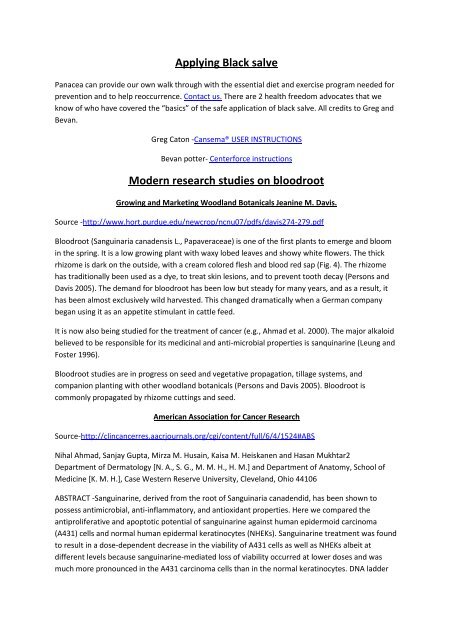Black Salve Alternative Cancer Treatment (1)
You also want an ePaper? Increase the reach of your titles
YUMPU automatically turns print PDFs into web optimized ePapers that Google loves.
Applying <strong>Black</strong> salve<br />
Panacea can provide our own walk through with the essential diet and exercise program needed for<br />
prevention and to help reoccurrence. Contact us. There are 2 health freedom advocates that we<br />
know of who have covered the “basics” of the safe application of black salve. All credits to Greg and<br />
Bevan.<br />
Greg Caton -Cansema® USER INSTRUCTIONS<br />
Bevan potter- Centerforce instructions<br />
Modern research studies on bloodroot<br />
Growing and Marketing Woodland Botanicals Jeanine M. Davis.<br />
Source -http://www.hort.purdue.edu/newcrop/ncnu07/pdfs/davis274-279.pdf<br />
Bloodroot (Sanguinaria canadensis L., Papaveraceae) is one of the first plants to emerge and bloom<br />
in the spring. It is a low growing plant with waxy lobed leaves and showy white flowers. The thick<br />
rhizome is dark on the outside, with a cream colored flesh and blood red sap (Fig. 4). The rhizome<br />
has traditionally been used as a dye, to treat skin lesions, and to prevent tooth decay (Persons and<br />
Davis 2005). The demand for bloodroot has been low but steady for many years, and as a result, it<br />
has been almost exclusively wild harvested. This changed dramatically when a German company<br />
began using it as an appetite stimulant in cattle feed.<br />
It is now also being studied for the treatment of cancer (e.g., Ahmad et al. 2000). The major alkaloid<br />
believed to be responsible for its medicinal and anti-microbial properties is sanquinarine (Leung and<br />
Foster 1996).<br />
Bloodroot studies are in progress on seed and vegetative propagation, tillage systems, and<br />
companion planting with other woodland botanicals (Persons and Davis 2005). Bloodroot is<br />
commonly propagated by rhizome cuttings and seed.<br />
American Association for <strong>Cancer</strong> Research<br />
Source-http://clincancerres.aacrjournals.org/cgi/content/full/6/4/1524#ABS<br />
Nihal Ahmad, Sanjay Gupta, Mirza M. Husain, Kaisa M. Heiskanen and Hasan Mukhtar2<br />
Department of Dermatology [N. A., S. G., M. M. H., H. M.] and Department of Anatomy, School of<br />
Medicine [K. M. H.], Case Western Reserve University, Cleveland, Ohio 44106<br />
ABSTRACT -Sanguinarine, derived from the root of Sanguinaria canadendid, has been shown to<br />
possess antimicrobial, anti-inflammatory, and antioxidant properties. Here we compared the<br />
antiproliferative and apoptotic potential of sanguinarine against human epidermoid carcinoma<br />
(A431) cells and normal human epidermal keratinocytes (NHEKs). Sanguinarine treatment was found<br />
to result in a dose-dependent decrease in the viability of A431 cells as well as NHEKs albeit at<br />
different levels because sanguinarine-mediated loss of viability occurred at lower doses and was<br />
much more pronounced in the A431 carcinoma cells than in the normal keratinocytes. DNA ladder



